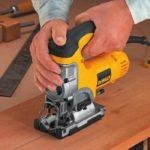No doubt, A reciprocating saw is one of the most effective power tools you can buy – yet they are ineffective with no blades. The blades do the job of cutting the material - be it precision or strength. There are different types of reciprocating saws blades for an unfamiliar task. So the questions may arise in the reader's mind.
What types of reciprocating saw blades are available?
Made for different applications, you can choose almost unlimited blades.
Whether it’s wood, metal, PVC piping, bushy - from standard blades to specialized blades - you name it, there’s a blade for it.
What are the Different Types of Reciprocating Saw Blades?
All the manufacturers try to Come up with better blades for power saw; reciprocating saw is not the privilege. Reciprocating saw blades types depend on cutting a variety of materials. The fundamental differences are in teeth per inch (TPI), blade material, and/or blade shape.
Hopefully, You will know that the blade has to be picked depending on your task type. Let's see which blade is best for every kind of task and for cutting different components.
Classification of reciprocating saw blades based on type of work
- Reciprocating saw blade for pruning
- Reciprocating saw blades for masonry
- Reciprocating saw blades for metal cutting
- Reciprocating saw blades for demolition work
- Special Purpose Blades
Best reciprocating saw blades for pruning
The best reciprocating saw blades for wood have some specific features that make them ideal for cutting wood smoothly and and is very effective for pruning trees. These blades come up with high-resistant teeth that ensure more extended durability while cutting through nails and other foreign objects. If you find reciprocating saw blades for pruning this chapter will benefit you.
The blades also bear the feature of six or more degree angle for fast and aggressive cuts. These blades also have the specially formulated anti-stick coating that minimizes the contact,and gum-up for a fine cut.
Pruning blades are available from 6 to 12-inches in length. We Recommend using a 9-inch high carbon steel blade with 4 to 8 TPI for pruning a tree.
A DEWALT DW4856 Woodcutting Reciprocating Saw Blade is a unique example of the best reciprocating blade for cutting wood straightly, and quickly. This blade also comes up with a raker tooth design that increases the contact area of timber for cutting faster.
Best reciprocating saw blades for metal
When you are going to buy the best reciprocating saw blades in the market for metal, you must consider some factors. One of the essential features to consider is the material that you are going to cut with the blade.
You must ensure that the blade is strong enough and it won't break during cutting metal. Teeth per inch are another essential feature that you must consider before buying the blades. It would be best if you remembered the more teeth there are, the more precise the cut will be.
The blades with at least 18 teeth per inch would be the best for cutting metal. They will ensure you get a smooth cut in almost all types of metals that you need to cut.
Bosch RM618 6-Inch 18T Metal Cutting Reciprocating Saw Blades is an extra heavy-duty bi-metal blade with coarse teeth that are highly suitable for cutting metal and concrete.
Reciprocating saw blades for masonry
Reciprocating saw for demolition work
Special Purpose Blades
Classification of reciprocating saw blades based on mater/ made of
- Demolition Blades
- Combination Blades
- Matal Cutting Blades
- Carbide Tipped Blades
- Carbide Grit Blades
Demolition Blades
Though Demolition Blades are best for cutting nail-embedded wood, you can apply it to cut various materials. You can use this blade for thicker and heavier duty applications that range from 6 to 11 TPI. You will find demo blades with different TPI to better cut the range of materials encountered in a demolition job.
Manufacturers have designed these extra-ordinary reciprocating-saw blades for cutting through a variety of specific materials. For demolition and remodeling work, this single blade is good enough to cut through almost all materials.
Perhaps, one minute you're working in clean wood, the next minute you're working in wood with nails, plastic, insulation, joist hangers, steel studs, or worst of all, asphalt roofing. In this situation, a demolition blade will be highly useful for your job.
Combination Blades
A combination blade is a type of blade configured with a group of five teeth -- four ATBs and one FT -- and a large gullet after each group. The user use combination circular saw blades enormously as they have multipurpose use.
You can use combination blades for ripping (cutting with the grain), cross-cutting (cutting across the grain), or mitering (cutting beveled edges to make a corner or joint) hardwoods, softwoods, plywood, and veneers.
Combination blades are perfect for those handymen and hobbyists whose projects don't need to be so accurate and don't want to buy more than one saw or spend a lot of time changing blades.
So, we can term it as an all-purpose saw blade.
The Armormax combination saw blade with non-stick coating reduces friction, provides smooth cuts, prevent rust, and ensure overall blade life. The main characteristic of this saw blade is the tooth pattern that has around 60 ATBR teeth.
Carbide-Tipped Blades
Carbide tipped blades bear carbon on the blade's edge, but the blade's main body is made of steel. The manufacturers use small tips of Carbide and braze them on to the body of the blade. A good carbide tip can hold an edge ten to twenty times longer than a steel tip tool.
Typically, the woodworkers and artisans use Carbide saw blades for precision cuts for projects that require minimal to no tear-out, such as cabinet making or furniture building. Generally, you can use Circular carbide tip blades with miter and table saws.
The structure and design of the blade will also vary depending on the thickness of the metal.
Carbide (or, more specifically, tungsten carbide and titanium carbide) is a widespread material used to make any cutting tool. For example, the producers make saw blades, lathe bits, drill bits, router bits, and dental drilling tips with the Carbide's combination.
Carbide Grit
Carbide grit blades are such types of blades that (typically tungsten carbide) don't have teeth like a traditional Sawzall blade. You can apply Carbide Grit Reciprocating Saw Blade to cut rigid, abrasive materials. The designers permanently bond the cutting edge of tungsten carbide particles to alloy steel back.
This type of blade has small carbine particles or industrial diamond grit along its cutting edge. It helps the blade cut cast iron, fiberglass, cement, metal, ceramic, and clay. The carbide grit hardness helps to cut these materials without damaging them or wearing out prematurely.
When you use this blade to cut wood, the blade will cut very slowly and probably make a fire. The blade can cut rigid materials that other blades can't do.
The Last Paragraph
You should know the specific types of a reciprocal saw blade. Also, have the right information on how they function on different materials. That will help you make an informed decision, which is the best reciprocal saw blades best for your project.
Hopefully, after reading the article, you will able to pick the best one.
Here’s to an excellent cutting experience!


















